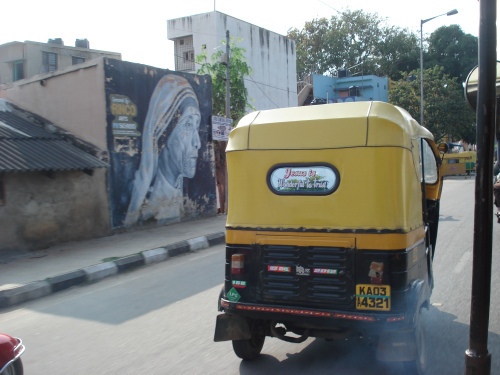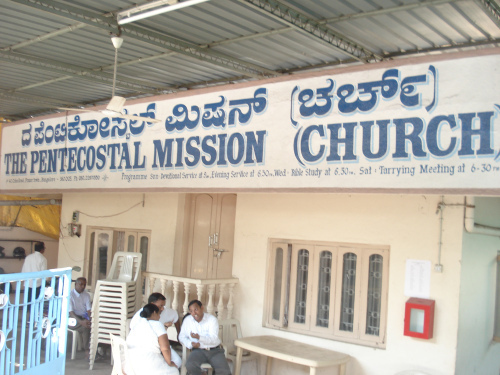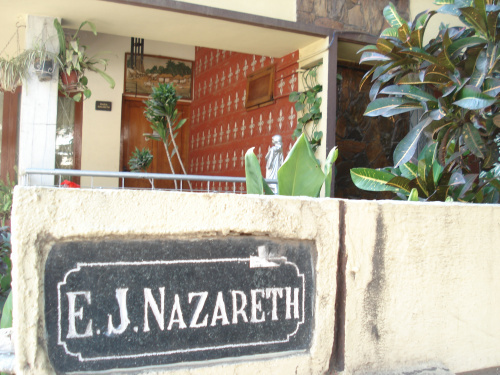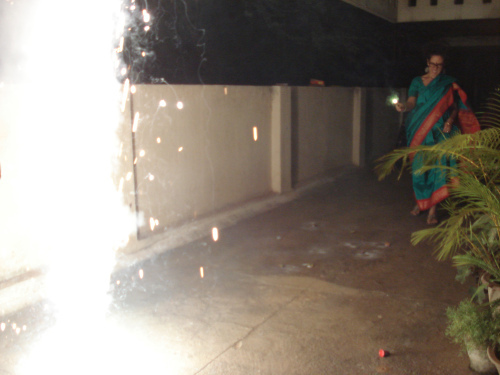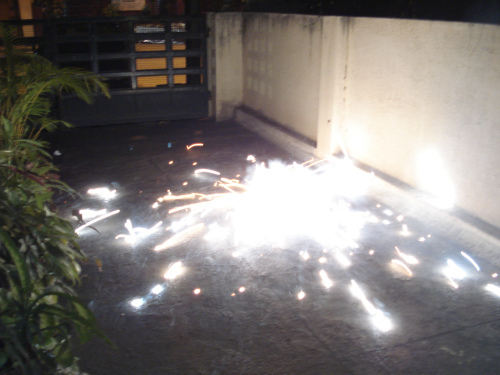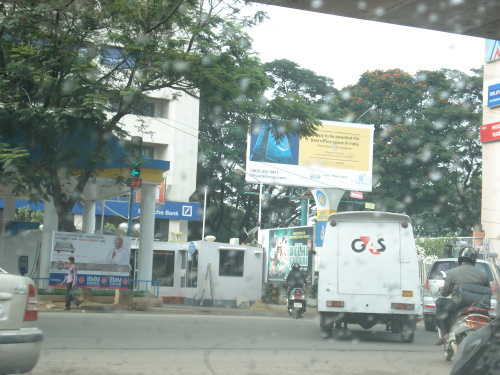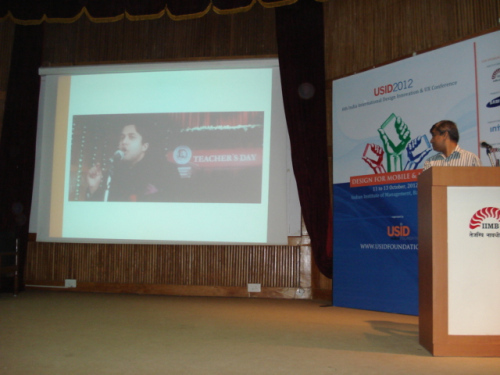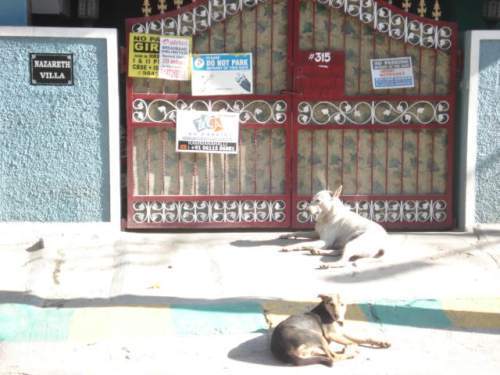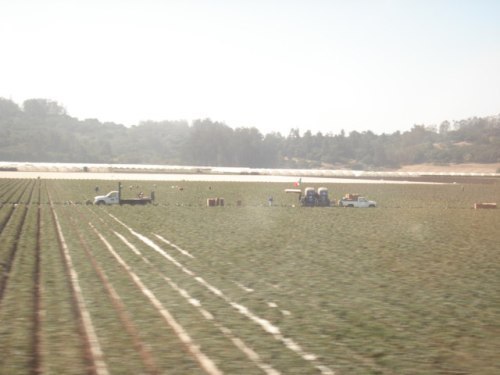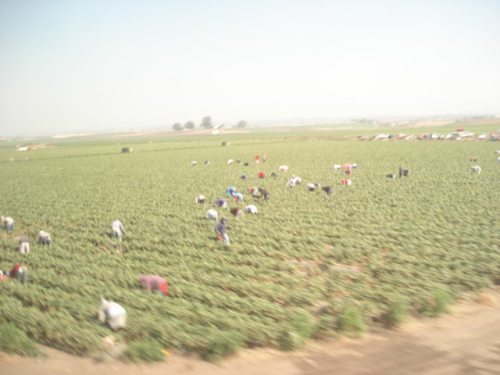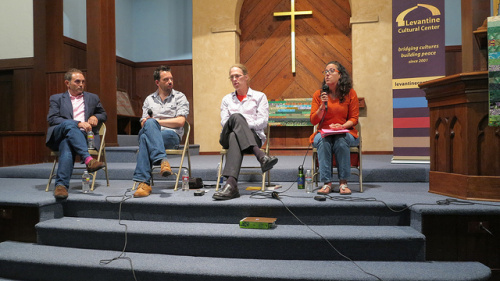Marcy Jane Knopf-Newman's Blog, page 4
January 17, 2013
G4S in India
So far I have seen three G4S offices in Bangalore alone. I have also seen their cars driving around the city. When I was in Darjeeling recently, I discovered that they also ran security for the Darjeeling zoo. They seem to operate as an ordinary security company, but they are anything but ordinary.
At present there is a campaign to vote for G4S as the worst company in the world. There are many reasons for this, but the main points of interest are related to G4S role in maintaining Israel’s colonization and occupation of Palestine, particularly its prisons, apartheid wall, and checkpoints. Writing for Electronic Intifada, Adri Nieuwhof explains their role:
The British-Danish security giant G4S has become the target of rights activists in different countries because of its provision of services to Israeli prisons, military checkpoints and to firms in illegal settlements in the West Bank.
In 2008, G4S Israel advertised its involvement with Israeli miitary checkpoints on its website. The text on the left of the screenshot above reads: “Systems for checking persons, manufactured by Safeview USA, first of their kind, were installed at the Erez checkpoint. The systems are in operational use by the army and enable the performance of full scans of the human body.”
G4S confirmed it had provided security equipment with “associated maintenance services” to the Israeli police, prison service and defense ministry, in a 21 December 2010 letter to the Business and Human Rights Resource Center in London. At the same time, the company claimed it did “not control” — and was not “necessarily aware” — where its security equipment was deployed “as it may be moved around the country.”
In the brochure, published by the Danish watchdog DanWatch, G4S describes the supply of a perimeter defense system for the walls around the Ofer prison compound and the installation of a central command room to monitor the entire Ofer compound. In addition, the company writes it also provided all the security systems in Ketziot prison and a central command room in Megiddo prison (G4S delivers technology to Israeli prisons,” DanWatch, 21 November 2010).
G4S boasts that the three prisons can detain 2,700-3,700 “security” prisoners — the majority of whom are Palestinians from the occupied West Bank and Gaza Strip illegally transferred to detention centers within Israel’s internationally-recognized boundary. International humanitarian law forbids an occupying power from transferring prisoners outside of the occupied territory and the conditions in Israeli prisons do not meet international legal standards. Accordingly, G4S’s involvement in the Israel Prison Service apparatus abets violations of international law.
G4S’s promotional material contradicts its claim that it does not know where its X-ray machines and body scanners are used. Who Profits? — a project of the Israeli Coalition of Women for Peace — has also documented that G4S luggage scanning equipment and full body scanners are used at checkpoints in the occupied West Bank towns of Qalandiya, Bethlehem and Irtah. G4S also provided full body scanners to the Erez checkpoint at Gaza. Who Profits? told The Electronic Intifada that this information is published in G4S’s own website and brochures.
As a result of these findings, BDS activists have been working to target G4S in various ways. And in 2012 there were several success:
The British firm Good Energy announced that it would end its business relationship with G4S, the private security giant with a track record of complicity in Israel’s human rights abuses.
After sustained media attention and pressure from BDS activists, several Danish charities and a bank decided to end security service contracts with the British-Danish security company G4S for the company’s role in Israel’s occupation.
The University of Oslo in Norway announced it would drop its contract with private security company G4S in July 2013 over the company’s involvement with Israeli prisons and its providing of services and equipment to checkpoints, Israel’s wall in the West Bank, settlement and settlement businesses.
One of my favorite actions targeting G4S last year was one done in London during the Israeli bombardment of Gaza.
A Danish bank, several major Danish NGOs and a UK energy supplier have all dropped their links with G4S after pressure from campaigners. The EU declined to renew a contract with G4S following a campaign supported by members of the European Parliament. Students at Edinburgh University in Scotland voted to block the union’s contract with G4S and students at Oslo university in Norway are campaigning for the university not to renew its contract with the security company when it expires in February 2014.
BDS is new in India, but it is growing especially among cultural workers and academics. I hope that it soon spreads to the economic sector, especially targeting multinational corporations like G4S.
Filed under: Activism, Apartheid, Boycott, Divestment & Sanctions, Human Rights, India, Occupation, Palestine, Prisons, Zionism Tagged: adri nieuwhof, bangalore, bds, Bethlehem, checkpoints, danwatch, darjeeling, denmark, edinburgh university, electronic intifada, erez, g4s, Gaza, good energy, irtah, london, michael deas, norway, Oslo, qalandia, richard falk, scotland, who profits


December 22, 2012
On Rape
One of the things I miss most about Beirut is the women of Nasawiya. I miss their spirit and energy. I miss the way they run their organization in a grassroots fashion in the purest sense of the word. Anyone who has a project or an issue they want to work on they do it. From the Anti-Racism Movement (which has a special focus on migrant domestic workers) to supporting refugees, Palestinian Syrian, and Sudanese, to standing in solidarity with Spinney’s workers on strike. There is such breadth in the way they connect feminism to other causes, something generally lacking in American feminist organizing.
Yesterday the women of Nasawiya were on my mind as I attended my first protest in India. There has been a lot in the media locally and internationally about rape here and I received an email from Vimochana, a local feminist organization that there would be a demonstration against sexual assault and to demand a change in the way the legal system handles rape cases. The initial impetus for this protest was the outrage many people in India feel about the gang rape of a twenty-three-year old student in Delhi who was gang raped for almost an hour on a bus before being thrown onto the road and left to die. This was last week. This week a fifteen-year-old girl was raped in a grocery store near her home here in Bangalore.
In the announcement for the protest these statistics about rape in Bangalore were shared:
97 cases were the registered rape cases in 2011 in Bangalore city which means 7 women victims each month. If the hundreds of cases of molestation, abductions of women, child sexual abuse, harassment and abuse on the streets/ auto rickshaws / buses or other public spaces in the city are counted then by any standard, living and working in the city is truly a daily hazard for women and children. The National Crime Records Bureau (NCRB) statistics for 2011 said Bangalore ranks fourth among cities of the country in recorded rape cases.
The numbers seem low by American standards, or even global standards. But the situation here seems shocking and most people are talking about it. Of course as is always the case with rape, it is underreported so statistics can only tell so much of the story. Regardless of the numbers, the stories, the fact that it happens at all and afterwards when women usually blamed, exacerbates and enflames the situation even for those not directly involved in the sexual assault.
I arrived at the protest a bit early and it seemed that a different organization, Women’s Voice, already had a protest underway. This consisted of women speaking to an audience of, largely women, sitting down and listening and at times called to chant in response. Since they were all speaking in Kannada I don’t know what they were saying, but a journalist near me, who was waiting for the second protest like me, mentioned that this was a bit orchestrated. She said that the organization bussed in women to put on a show. I’m not sure whether this is the case or not. But their protest was certainly lively, including the burning of a scarecrow-rapist in effigy.
The second protest began under the banner of Women in Black India and it seems that this group had various people involved, including a lot of students. In both cases the demands are similar wanting to change the legal system, sensitize the police force, stop the rape examination (which involves a woman being subjected to a doctor placing two fingers into her vagina to see whether or not she is used to sexual intercourse) among other things.
Here are some more essays/editorials on the Indian rape cases:
India: Hundreds of Men Accused of Sexual Assault Stand for Election
And here is a report on the Delhi protest the other day:
[image error]
[image error]
[image error]
[image error]
[image error]
[image error]
[image error]
[image error]
[image error]
[image error]
[image error]
[image error]
[image error]
[image error]
[image error]
[image error]
[image error]
[image error]
[image error]
[image error]
[image error]
[image error]
Filed under: Activism, Feminism, Human Rights, India, Lebanon Tagged: anti-racism movement, bangalore, beirut, delhi, domestic workers, kannada, nasawiya, rape, refugees, spinney's, vimochana, women in black, women's voice


December 11, 2012
A Week in Lucknow
I spent last week visiting a friend in Lucknow in the northern part of the country (more pictures in gallery below). Our first day we ventured out to the village of Malihabad so she could conduct some research she is doing about nurseries and seeds. Much of the agricultural land is being converted from local food production to decorative house plants and flowers for export. Prior to our trip, she was online doing a bit of last-minute research on the village when she stumbled upon this little gem:
It is not clear what the purpose of this research is or how the Israeli government would use such information. In any case, the researcher involved clearly doesn’t know about the academic boycott of Israel given that he’s taking funds from the Israeli government to conduct his research. He also seems to be under the mistaken impression that there is some kind of historical enmity between Jews and Muslims when that is not the case. But the largest problem in the blog piece is its erroneous concluding paragraph:
Navras said that as per history, ten Israelite tribes of the northern kingdom of Israel were exiled by the Assyrian invaders in 721 BC. It is believed that some descendants of these lost tribes settled in India between AD 1202 and AD 1761. Afridi Pathans of Malihabad are said to be one of them. Some Israeli academicians have visited Malihabad in the last few years to study customs and traditions of Pathans to find if they have any resemblance to Israelite traditions.
In fact, if he had read Israeli historian Shlomo Sand’s book The Invention of the Jewish People, he would know that:
the Romans never deported entire peoples. We might add that neither did the Assyrians and Babylonians move entire populations from the countries they conquered. It did not pay to uproot the people of the land, the cultivators of produce, the taxpayers. But even the efficient policy of deportation practiced by the Assyrian, and later the Babylonian, empire—in which whole sections of local administrative and cultural elites were deported—was not followed by the Roman Empire. (130)
Notice that while the Assyrians did deport some people, it idid not exile entire peoples and its deportation policy was not about one’s religion.
From one colonial context to another.
After Malihabad we went to what is known as the Residency. It seems that each Indian city has a place with this name as it was once the home of the British colonials ruling the area. But the one in Lucknow is special. You can see it in photographs below more clearly. It was the site of the 1857 uprising (mutiny as the English refer to it) against the British. This expansive space includes the shells of all the former buildings that were destroyed during the Indian uprising against their colonial rulers. It’s quite impressive that one can still see this colonial history–and resistance to it–preserved in such a remarkable way.
My friend’s childhood friend was speaking at a commemoration of Swami Vivekananda’s famous 1893 speech in Chicago at the Columbian Exposition, which celebrated Christopher Columbus’ colonization of the Americas. I had read about him in Vijay Prashad’s The Karma of Brown Folk, but did not remember much about him at the time. Prashad paints him in an interesting light–as one who plays almost a trickster role to the Americans wanting to Orientalize him and fetishize his Hindu beliefs. And, according to Prashad, he was quite critical of the way Americans approached religion:
You Americans worship what? The dollar. Int he mad rush for gold, you forget the spiritual until you have become a nation of materialists. Even your preachers and churches are tainted with the all-perfading desire. (35)
Yet I was struck by a different set of beliefs that he conveyed in that speech as I heard it in the Bengali association hall last week. Here is the part that I was taken aback by:
I am proud to belong to a nation which has sheltered the persecuted and the refugees of all religions and all nations of the earth. I am proud to tell you that we have gathered in our bosom the purest remnant of the Israelites, who came to the southern India and took refuge with us in the very year in which their holy temple was shattered to pieces by Roman tyranny.
Obviously, in 1893 when Zionism was in its incipient stages, there were no Shlomo Sands to historicize the Roman presence in West Asia, alerting us to the fact that the Romans never expelled any people. And yet on this trip I was hearing yet another allusion to Jewish expulsion (although often it is also that they are the 12th tribe who wandered and got lost) from Western Asia, which is often the historical argument used for how Jews arrived in India over a century ago.
The other main attraction I visited in Lucknow was the Bara Imbara, which is a fantastically preserved, beautifully designed Nawab palace from the eighteenth century:
This space, much like the Residency, is filled with fabulous nooks and crannies that seem to make the best hide-and-go-seek playgrounds for children. But in the Imbara there is also a labyrinth, which you need to hire a guide to take you through. One must travel up and down several flights of steep stairs and through a series of narrow hallways to navigate this area. There are interesting nooks, such as a passage way that leads underground, which people used to use to travel surreptitiously from one city to the next. However, the British closed it up. There are also several clever engineering feats that enable communication from one far off location along the same wall. Supposedly there is also a buried treasure there, but in order to discover it the entire property would need to be destroyed.
The photographs below are a bit mixed up, but they are of the places I mention above, plus random snapshots of the city, a couple of AIDS protests we saw because I was there during World AIDS Day, and its incredible food–especially the chaat and paan!
[image error]
[image error]
[image error]
[image error]
[image error]
[image error]
[image error]
[image error]
[image error]
[image error]
[image error]
[image error]
[image error]
[image error]
[image error]
[image error]
[image error]
[image error]
[image error]
[image error]
[image error]
[image error]
[image error]
[image error]
[image error]
[image error]
[image error]
[image error]
[image error]
[image error]
[image error]
[image error]
[image error]
[image error]
[image error]
[image error]
[image error]
[image error]
[image error]
[image error]
[image error]
[image error]
[image error]
[image error]
[image error]
[image error]
[image error]
[image error]
[image error]
[image error]
[image error]
[image error]
[image error]
[image error]
[image error]
[image error]
[image error]
[image error]
[image error]
[image error]
[image error]
[image error]
[image error]
Filed under: Boycott, Divestment & Sanctions, Colonialism, History, India, Zionism Tagged: 1857, afridi pathans, aids, assyrians, babylonian, bara imbara, bds, british, chicago, christopher columbus, columbian exposition, dna, indian jews, israelite, lucknow, malihabad, mumbai, mutiny, nawab, nawabi, residency, roman, shahnaz ali, shlomo sand, swami vivekananda, uprising, vijay prashad, western asia


November 26, 2012
The Infant and the Infantry
When I first moved to Boise, Idaho, I received a welcome package on my doorstep. I can’t remember all that was in it, but there was a VHS tape introducing me to all of Boise’s churches. At the time I recall never having lived in a city with so many churches. But most of the time I didn’t see them because many were out in the suburbs. Their presence was ever present, however.
When I spent a semester teaching in Ghana, I was struck by the intensity of Christianity in the southern half of the country where I lived. There it felt different. It felt intensely colonial. The Mormon church in the center of Accra, in particular, with its excessive gold monument on top, was just one of many ways I found this Western Christian presence oppressive. It was the missionary presence, which felt all too colonial, that made it such. But even more than that: the presence of these churches and missionaries seemed to be coupled with images of white Jesus that were ubiquitous. I found them on taxis, cars, tro-tros, decorating businesses–everywhere. Most Ghanaians didn’t seem to get the irony of praying to a white man who came from Palestine (i.e., not the West). Below are some photos of those churches and images of white Jesus I took at the time.
[image error]
[image error]
[image error]
[image error]
[image error]
[image error]
[image error]
[image error]
[image error]
[image error]
[image error]
[image error]
[image error]
[image error]
[image error]
[image error]
[image error]
[image error]
[image error]
[image error]
[image error]
[image error]
[image error]
[image error]
[image error]
[image error]
[image error]
[image error]
[image error]
[image error]
[image error]
[image error]
[image error]
[image error]
[image error]
[image error]
[image error]
[image error]
[image error]
[image error]
[image error]
[image error]
[image error]
[image error]
[image error]
[image error]
[image error]
[image error]
[image error]
[image error]
[image error]
[image error]
[image error]
[image error]
[image error]
[image error]
[image error]
[image error]
[image error]
[image error]
[image error]
[image error]
[image error]
[image error]
[image error]
[image error]
[image error]
[image error]
[image error]
[image error]
[image error]
[image error]
[image error]
[image error]
[image error]
[image error]
[image error]
[image error]
[image error]
[image error]
[image error]
[image error]
[image error]
[image error]
[image error]
[image error]
[image error]
[image error]
[image error]
[image error]
[image error]
[image error]
[image error]
[image error]
[image error]
[image error]
[image error]
[image error]
[image error]
[image error]
[image error]
[image error]
[image error]
[image error]
[image error]
[image error]
[image error]
[image error]
[image error]
[image error]
[image error]
[image error]
[image error]
[image error]
[image error]
[image error]
[image error]
[image error]
[image error]
[image error]
[image error]
[image error]
[image error]
[image error]
[image error]
[image error]
[image error]
[image error]
[image error]
[image error]
[image error]
[image error]
[image error]
[image error]
[image error]
[image error]
[image error]
[image error]
[image error]
[image error]
[image error]
[image error]
[image error]
[image error]
[image error]
[image error]
[image error]
[image error]
[image error]
[image error]
[image error]
[image error]
[image error]
[image error]
[image error]
[image error]
[image error]
[image error]
[image error]
[image error]
[image error]
[image error]
[image error]
[image error]
[image error]
[image error]
[image error]
[image error]
[image error]
[image error]
[image error]
[image error]
[image error]
[image error]
Now I am in Bangalore and feeling that the missionary presence is even greater here–and even more oppressive. As I mentioned in an earlier post, this city was once a cantonment for the British army. Now all that land is occupied by the Indian armed forces. But equally pervasive, as far as I can tell, are the other hold over from colonial days: the churches. Thus, the title for this post: the infantry should be obvious. The infant is the baby Jesus. For there are many code names, often in Sanskrit, sometimes in English, in ways that attempt to disguise what is being alluded to. So the word infant becomes shorthand for baby Jesus. And it is a word one would be hard pressed to avoid as you wander through this city. Just in the little northeast quadrant of the city I’ve seen, and photographed, over 200 churches. Each Sunday I take a walk around a new neighborhood near where I live and discover even more. I live in an area that was once heavily populated by Anglo Indians. It’s now a mixture of Indian Christians, Hindus, and Muslims, and a few foreigners are sprinkled into the mix as well.
But it is not just the churches and their missionary energy and colonial presence that I find disturbing. (For anyone who still associates Mother Theresa with India–see mural at the top of this post–I strongly advise you to read Christopher Hitchens’ work on the subject as he wrote it when he was at the top of his game and he got her dead on in a way no one else ever did.) It is the type of churches that are the most aggressive in this respect that I see all around me–American churches like the Jehovah’s Witnesses, Baptists, Pentecostals, and other variations on evangelism. As with in Ghana, their presence is not only in the churches, but also translates into people’s names and into their business names.
In Bangalore one can see this in the expected way with names like John or Mary. But what is unexpected are the names associated with Palestine like Nazareth and Hebron. But the more I wandered around, the more I saw that did not seem to be related to Palestine per se, but rather to the specific American brand of Christian Zionism that often comes with various brands of evangelical Christianity. One can see this, too, in everything from the names of churches to signs on ordinary businesses. When I Googled Bangalore and Zion, I found a number of businesses that turned up from IT companies to money changers to hospitals and clinics. 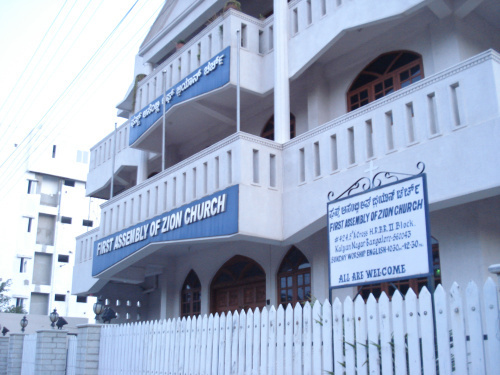
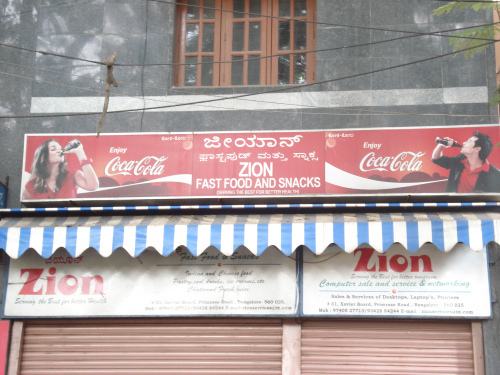 Given the fact that there is a plethora of these symbols and signs related to evangelical Christianity and Zionism, it makes me suspicious of other signs that are dispersed around the city, such as the otherwise innocuous “shalom,” Hebrew for hello or peace that once finds decorating the entrance ways to many people’s homes here. Below find an album of my photographs of Christian and Zionist Bangalore (note the Ghana photos may be tacked on at the end).
Given the fact that there is a plethora of these symbols and signs related to evangelical Christianity and Zionism, it makes me suspicious of other signs that are dispersed around the city, such as the otherwise innocuous “shalom,” Hebrew for hello or peace that once finds decorating the entrance ways to many people’s homes here. Below find an album of my photographs of Christian and Zionist Bangalore (note the Ghana photos may be tacked on at the end).
Click to view slideshow.
Filed under: Christianity, Colonialism, India, Palestine, Zionism Tagged: accra, anglo indians, bangalore, baptists, boise, british army, christian zionism, christopher hitchens, churches, cufi, ghana, Hebron, infant, jehovah's witnesses, jesus, missionary, mormon, mother theresa, nazareth, pentecostals


November 19, 2012
Sounds of Deepawali, Sounds of Gaza
Last week was Deepawali or Diwali for short. A simplified explanation of the holiday is that is a festival of lights. But one cannot have lights without sound especially given the fact that this holiday is celebrated with firecrackers and fireworks. If I had thought about it in advance, I would have recorded the sounds, especially as I experienced them on a brief auto rickshaw trip in which the driver had to dodge children lighting various explosives in the streets. Like a lot of sounds in Bangalore, especially traffic, they are constant and quite loud. And even government officials attempted to intervene in lessening the noise pollution. I let off a few firecrackers for the first time in my life in spite of my trepidation. But the sounds of Diwali–which lasted for three days–reminded me of other places and times.
The sound of fireworks and firecrackers sound just like bombs and gunfire to me. I can’t help it. The sounds are indistinguishable for me. So as much as I enjoyed the way they look when they are lit up, in the back of my mind it conjured up less pleasant memories of Palestine and Lebanon.
It is a week later, and although I’m miles away, the sounds of Israel’s latest bombardment of Gaza are the only sounds I am imagining even though I know that sound is far worse and, of course, has lethal effects. Rana Baker had the foresight to record some of those sounds of what it is like in Gaza right now.
It seems like deja vu–as if it is 2008 again. Of course so much has changed since then, but then again so much has not, which Haidar Eid writes about lucidly, especially in light of the Arab uprisings. For those who are unaware of what happened and how it all began, Ali Abunimah has a timeline that clearly illustrates how Israel broke its truce with Gaza and began its latest escalation. You can also see Abunimah on Al Jazeera explaining this timeline to a rather ill-informed interviewer:
This new war is, in many ways, an ongoing one as anyone who monitors Palestine knows. Gaza, in particular, has been kept on a “diet,” as Sherene Seikaly points out in Jadaliyya. As before, too, the language coming from the Zionist regime spans the gamut from calling for a holocaust to “flattening” Gaza like Hiroshima. Even a local paper in Bangalore had a headline yesterday about Israel bombing Gaza back to the Middle Ages.
This time it is more difficult as I am so far away from Palestine. Although during the last war, even though I was in Nablus, I might as well have been in India given how far removed we were from the people with no ability to connect with them in any way other than phone calls and email. And the one protest I know of in India happened in Delhi today, miles away from Bangalore. But the media here, especially English language media, is focused on so many more local issues, many of which are equally disturbing and troubling. And the international media available here is anything but helpful, spewing as it does Israeli propaganda at every turn. And still my heart and my mind are occupied with Gaza hoping that the fruits of the Arab uprisings make a difference this time.
For those who wish to do something, as always, BDS is the way to go. The Boycott National Committee created a handy sheet about 5 ways you can effectively support Gaza through BDS.
Also see: the Guardian‘s interactive map on Gaza
IMEMU’s fact sheet on Gaza and Israel’s policies towards Gaza
Filed under: Apartheid, Boycott, Divestment & Sanctions, Colonialism, India, Militarization, Occupation, Palestine, Zionism Tagged: Al Jazeera, Ali Abunimah, arab uprisings, bangalore, bds, deepawali, delhi, diwali, Gaza, haidar eid, hiroshima, holocaust, imemu, jadaliyya, middle ages, rana baker, shahad abusalama, sherene seikaly


October 22, 2012
A Bit of Beirut in Bangalore
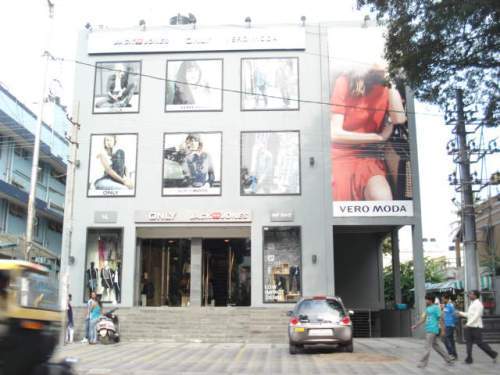 One of the first things I noticed driving around Bangalore is the way in which all the foreign-owned shops resemble those one would find in Hamra. In particular, the store Vero Modo/Jack Jones, since the time I first moved to Beirut in 2006, multiplied like rabbits along Hamra Street. It isn’t that bad here yet, but here is what one creative genius imagined Hamra Street might look like in the future if things continue at this pace. I hope it is not what is in store for Bangalore.
One of the first things I noticed driving around Bangalore is the way in which all the foreign-owned shops resemble those one would find in Hamra. In particular, the store Vero Modo/Jack Jones, since the time I first moved to Beirut in 2006, multiplied like rabbits along Hamra Street. It isn’t that bad here yet, but here is what one creative genius imagined Hamra Street might look like in the future if things continue at this pace. I hope it is not what is in store for Bangalore.

Below are more photographs of more foreign shops that one can find in Bangalore and in Beirut. Most were taken at high-end malls. The set of interior/night time shots were taken at a place called UB City, which used to be a brewery factory. But it was transformed into this luxury mall that reminds me of Solidere in Beirut a great deal. In some ways it is even worse in the sense that it is structurally inhibiting and challenging for people to just wander in and walk around. Thus, it keeps out people for whom the mall is out of their league. It also reminded me quite a bit of the malls in Las Vegas. Anyone wanting excellent context for the damage that Solidere caused to Beirut society should read Saree Makdisi’s article on the topic. I cannot find a similar kind of analysis of UB City or the gentrification of Bangalore. However, the article below hints at some context:
The new IT prosperity has created a young, energetic, educated, and wealthy working class, transforming Bangalore into a consumer’s paradise of shopping malls and office complexes with glass-fronted exteriors. The insatiable demand for “good English” has renewed the anxiety that Kannada may die out in the city.
The scary part of what is written above is not only the bit about gentrification and the way it changes the urban landscape. (I’m reading Sarah Schulman’s brilliant The Gentrification of the Mind at present and offers interesting ways to connect the methods of gentrifying urban and mental landscapes.) I’ve been collecting photographs on Kannada architecture that shows how the outskirts of Bangalore have shifted from village to city; I’ll post those soon. But I am equally worried about the dangers of a people losing their language, especially to the imperial language of English. I saw an interesting film this past weekend that touches on some of these themes. The film, English Vinglish, features a protagonist who is ridiculed by her family for not knowing the English language. Here is a trailer:

My favorite scene in the above clip is when she goes to pick up her American visa and the American sitting behind the counter asks how she’ll survive in the U.S. without knowing English; the retort by his colleague is brilliant (at the end of the clip): “the same way you survive in our country without learning Hindi.”
One last piece of Bangalore that, unfortunately, resembles Beirut. It is the presence of G4S, which I saw this morning for the first time. Here is a bit about what G4S is and why there is a boycott campaign against them:
In 2007, G4S signed a contract with the Israeli Prison Authority to provide security systems and other services for major Israeli prisons. G4S provides systems for the Ketziot and Megiddo prisons, which hold Palestinian political prisoners from occupied Palestinian territory inside Israel. Article 76 of the Fourth Geneva Convention prohibits the transfer of prisoners from occupied territory into the territory of the occupier.
In Beirut I see G4S everywhere from the security at office buildings to friends’ apartments. Here is a bit about their role in Lebanon:
The scale of the work G4S do in Lebanon is unclear, with even Bawab saying he didn’t know exactly what they did in the country. But the head of a rival private security firm says they have “a couple of hundred guys” in the country, and it is not uncommon to see men in clothes with the company’s logo guarding private companies in Beirut’s Hamra.
Al-Akhbar discovered that the firm carried out a security review for the country’s preeminent university, the American University of Beirut. The 60-page confidential document details potential improvements that could be made to security and recommends that G4S operatives take over the running of the university’s security.
[image error]
[image error]
[image error]
[image error]
[image error]
[image error]
[image error]
[image error]
[image error]
[image error]
[image error]
[image error]
[image error]
[image error]
[image error]
[image error]
[image error]
Filed under: Apartheid, Boycott, Divestment & Sanctions, Globalization, India, Palestine, Prisons Tagged: bangalore, bds, beirut, english vinglish, g4s, gentrification, hamra, hindi, jack jones, kannada, language, sarah schulman, saree makdisi, solidere, ub city, vero modo


October 12, 2012
Aal Izz Well
I made a pilgrimage of sorts the other day, although it was an accident. I accompanied my partner to a conference at the Indian Institute of Management for a conference he was attending on design, mobile telephones, and mobility. (Check out USID–the sponsor of the conference–and especially its Gurukul program for students.) I just went to see what the campus looked like. But as we drove inside my fiancé remembered that one of my all time favorite movies, 3 Idiots, was filmed there. (The top photograph of me is in front of the water tower where a few of the infamous scenes of the film take place.)
I love this film not only because it is highly entertaining and heartwarming, but also because it represents the best critique of education, not only in India, but globally too. Incidentally, Aamir Khan, who stars in 3 Idiots, also stared in and directed Taare Zameen Par, which is another amazing film about education at the elementary level. It’s also well worth watching.
I walked around campus a bit–its quite large and feels more like a botanical garden than a university campus. The landscape design is gorgeous. But the architecture of the campus buildings is not particularly enthralling. What the landscape designers, I imagine, did was to compensate for the oppressive style of the buildings by planting flowers and trees all over the place so that it is filled with green and a stunning array of colors (see photo gallery below).


I also attended a couple of sessions, which turned out to be in the same auditorium as the one used in 3 Idiots when the character Chatur (AKA the Silencer) demonstrates his idiocy when he memorizes a speech in Hindi (because he grew up outside India and is not fluent). His classmates changed some of the words so that he would make a fool of himself before his professors and peers (see above videos–the second one presents it with a bit of context to show you how they pulled the prank). The image above of the head of USID speaking shows Chatur on the screen behind him; there is also one of me in the audience above. Below is a scene that takes place in a courtyard (photo of it in the gallery below) and it is one of the fabulous opening scenes that show you how the protagonist, Rancho, challenges the educational system. A second one, also below, is equally brilliant.


But the classic scene in the movie is of the amazing song “Aal Izz Well,” which is shot all over the campus so you can compare my photographs with it while enjoying the song below.

Finally, here are some other cool folks I learned about through the conference who are doing interesting work in Bangalore: Awaaz and Janaagraha.
On an entirely unrelated note, but worth noting nevertheless, yesterday before going to the conference here was a headline in our local Bangalore paper:
A top scientific panel of the government has favoured introduction of more genetically modified crops in the country under strict regulatory supervision because of the technology’s “transformational potential” in benefiting Indian agriculture.
This idiocy must be counteracted with Vandana Shiva once again. A reminder, first, of an interview with her in the Guardian the other day, which deals with this very issue. But more importantly, her organization, Navdanya, is organizing something called Seed Freedom, which people from around the world can participate in October 2-16. That’s a great way to work towards making sure that aal izz well with the global food system.
[image error]
[image error]
[image error]
[image error]
[image error]
[image error]
[image error]
[image error]
[image error]
[image error]
[image error]
[image error]
[image error]
[image error]
[image error]
[image error]
[image error]
[image error]
[image error]
[image error]
[image error]
[image error]
[image error]
[image error]
[image error]
[image error]
[image error]
[image error]
[image error]
[image error]
[image error]
[image error]
[image error]
[image error]
[image error]
[image error]
[image error]
[image error]
[image error]
[image error]
[image error]
[image error]
[image error]
[image error]
[image error]
[image error]
Filed under: Education, Environment, Film, India Tagged: 3 idiots, aamir khan, awaaz, bangalore, gurukul, indian institute of management, janaagraha, navdanya, seed freedom, taare zameen par, usid, vandana shiva


October 8, 2012
Bangalore Bandh
I’ve finally arrived in Bangalore about a week ago. I went directly to Ayurvedagram, about forty minutes outside the city, for a relaxing retreat filled with gorgeous Kerala-style homes (see photo gallery below), where one stays, receives treatment, dines, and does yoga and meditation. It was an amazing way to begin my stay here.
When I returned to Bangalore I decided to venture out in an auto rickshaw by myself to run a few errands and see the city (see photo gallery below). I’m struck by all of the amazing colors surrounding me in people’s clothes and on Hindu temples, of course, but also the colors of homes and other buildings. It is also more green than I had imagined, especially given the size and population density of the city. As I travel around and through this city most of the land seems to be occupied by either the Indian army (Bangalore was a garrison town for the British when they colonized India) or various foreign (and largely American) churches, which are actively proselytizing Indians, and as a result, are eroding the cultural landscape and traditional practices. It’s like there are visible remnants from the colonial days of the Bible in one hand and the sword in the other. You can see this in various ways just in my neighborhood: the pork shop across the street from the mosque; the use of names like Nazareth (see photo below with name on house gate), Hebron, and even shalom, by evangelical Christians. I think I’ve seen even more churches in the past couple of days than I did when I lived in Accra, Ghana, which is a bit surprising.
Since I moved into my new home, I have spent time getting settled, unpacking. But my first full day in my new house, Saturday, was also a day that I could not leave the house because there was a bandh (or a strike) in Bangalore over water issues between Karnataka (the state where I now call home) and the neighboring state of Tamil Nadu. Just like in my former home countries of Palestine (see MECA’s Maia Project on this), Jordan, and Lebanon, India, especially where I am located, has serious water issues. Vandana Shiva’s book Water Wars details some of these problems, and here she is in the film Blue Gold talking about water issues related to another problem, which is Coca-Cola’s pollution of water sources in India:

Karnataka seems to be doing some interesting things to combat this problem of water shortage, including legislating that people have to have some kind of rain water harvesting system in their homes. We have one here. But even that is not enough. There are several systems (in fact each sink has three sets of faucets) that are used in the house to access water from the ground water system (where our rain harvesting feeds into) or the delivered water to the tank, which only happens three days per week. It’s a complicated system that I haven’t fully figured out yet.
Yesterday I had lunch with my family at Cholayil Sanjeevanam, which is an amazing Kerala-based Ayurvedic restaurant. If you click the above link and go to their Facebook page you’ll see photographs of the amazing lunch, called rajakeeyam, but the image below gives you an idea of the menu and the rationale behind it.
After the fabulous, delicious lunch we went to the Sunday farmer’s market, which is quite large (more photos in gallery below) and fruits and vegetables we brought home were divine.
[image error]
[image error]
[image error]
[image error]
[image error]
[image error]
[image error]
[image error]
[image error]
[image error]
[image error]
[image error]
[image error]
[image error]
[image error]
[image error]
[image error]
[image error]
[image error]
[image error]
[image error]
[image error]
[image error]
[image error]
[image error]
[image error]
[image error]
[image error]
[image error]
[image error]
[image error]
[image error]
[image error]
[image error]
[image error]
[image error]
[image error]
[image error]
[image error]
[image error]
[image error]
[image error]
[image error]
[image error]
[image error]
[image error]
[image error]
[image error]
[image error]
[image error]
[image error]
[image error]
[image error]
[image error]
[image error]
[image error]
[image error]
[image error]
[image error]
[image error]
[image error]
[image error]
[image error]
[image error]
[image error]
[image error]
[image error]
[image error]
[image error]
[image error]
[image error]
[image error]
[image error]
[image error]
[image error]
[image error]
[image error]
[image error]
[image error]
[image error]
[image error]
[image error]
[image error]
[image error]
[image error]
[image error]
[image error]
[image error]
[image error]
[image error]
[image error]
Filed under: Environment, India, Religion Tagged: ayurveda, ayurvedagram, bandh, bangalore, bible, blue gold, cholayil sanjeevanam, church, coca cola, ghana, Hebron, karnataka, kerala, missionaries, nazareth, pollution, proselytizing, rain water harvesting, rajakeevam, Tamil Nadu, vandana shiva, water, water wars


September 26, 2012
California Travels
For the past couple of weeks I’ve been traveling across my home state of California. Because I was on the train between Berkeley and Los Angeles I had a lot of time to look out the window and think about the land I was traveling through. The first thoughts that entered my mind were about the indigenous peoples whose land was stolen in order to create all the settlements, military bases, universities, etc. One can begin learning about the history of indigenous California here.
I was also thinking about more recent history because I spent most of my train ride reading Mike Davis’ City of Quartz. After spending so much time studying the Arab World, I’m learning about the history of where I come from, Los Angeles, California. Davis’ book is amazing because it gives so much context to things I only heard about or partially understood growing up. I also watched Gregory Nava’s brilliant film El Norte again, which shows the challenges and the push factors compelling people to leave their land and labor in the U.S. (see trailer below). Apparently there is a new documentary called Harvest of Empire detailing these push factors. One thing is for sure, the economy here, and in most of the U.S. economy would not function without people willing to do all the difficult, dirty work that the majority of Americans are unwilling to do.

I thought a lot about the farm land and farmworkers I watched as my train passed by. This was, of course, not hard to do give how much agribusiness is in the heartland of California. It made me think of the Delano Grape Boycott organized by César Chávez throughout much of my childhood. It also made me think of the important ballot initiative in the upcoming election and California’s Proposition 37, which would require food producers to label all GMOs used in their products.
I traveled north for a book event at the Middle East Children’s Alliance, which turned out to be a terrific event. Lots of teachers showed up, which is what I hoped for. But also there were people from various periods of my life–friends from elementary school, from Boise, and various other periods and places in between.
Upon my return there was another hearing for the renewal of the Veolia contract with the Los Angeles city council. This time we spoke before the entire city council (although they seemed infinitely more interested in playing with their phones or reading the newspaper so I doubt they listened). In any case, they voted unanimously to renew the Veolia contract at the beginning of the meeting. We merely spoke to express our opposition to that vote. Prior to our speaking a woman involved in the Los Angeles sister city program was being honored. I had noticed, for the first time, on my walk to City Hall that there is a street sign (see above) indicating all of the sister cities connected to Los Angeles. One of them is Beirut. But another one is Eilat, an Israeli city in occupied Palestine. This is a city that only a month ago was protesting the inclusion of Sudanese children into their schools. Yet another example of the inherent racism of Zionism. While Los Angelenos seem to think it is a problem to fight racism and apartheid in Palestine, it seems that Quakers do not. Quakers not only voted to boycott Veolia, but Hewlitt Packard as well. There are audio reports about the Los Angeles vote and organizing around it which can be listened to here and here.
My second book event at the Levantine Center, with Mark Levine, Antony Loewenstein, and Saree Makdisi took place in Los Angeles at a church near UCLA. This event was larger, but it included other people. In any case, the discussion was quite interesting on a number of levels, not the least of which were the Iranian Jews in the audience whose heads were so immersed in Zionist propaganda that one woman denied the existence of the murder of Mohammad al-Durra and the massacre in Jenin refugee camp–two events that I discuss in my book, actually. Of course, it sounded exactly like Nazi holocaust denial, which is what I said to the woman. The event was filmed so if it becomes available I will post it.
Filed under: Apartheid, Boycott, Divestment & Sanctions, Colonialism, Economy, Indigenous, Labor, Palestine, Racism, Refugees, U.S. Foreign Policy, U.S. Policy, Zionism Tagged: antony loewenstein, california, César Chávez, delano grape boycott, eilat, el norte, gregory nava, harvest of empire, hewlitt packard, holocaust, Jenin, jenin refugee camp, levantine cultural center, Los Angeles, mark levine, Middle East Children's Alliance, mike davis, mohammad al durra, quakers, saree makdisi, sister cities, Sudan, veolia


September 15, 2012
Missiles Falling
I spent yesterday on an Amtrak train from Los Angeles to Oakland along the coast of California. I’m here for a few days for a speaking event at Middle East Children’s Alliance tomorrow at 2 PM. I haven’t taken this train since I was about 12 and my family traveled between Seattle and Los Angeles during Christmas. That time all I remember is that there was some weather problem and we had to back up for 8 hours or so and take an alternate route.
This time it was a bit less eventful in some ways, more so in others. This time the train was delated, too, but for a very different reason. Somewhere between Santa Barbara and San Luis Obispo the train stopped for 2 hours in order to let the Vandenberg Air Force Base launch missiles into the sea. Meanwhile, I sat in my chair, enjoyed the view, the books I read, and the ride.
I decided to take the train because I have the time, there is no ridiculous airport-style security system, and you can bring your own food and drinks on the train with you. There are other perks too: lots of leg room and a beautiful scenic view along the way (see photo gallery below).
But what I did not expect was the less than pleasant dining car experience. During lunch I endured a mathematician sharing his pride at having helped to build drones (those lovely instruments that massacre people in places like Yemen and Pakistan every week, drone attacks that have increased exponentially on Obama’s watch). I interrupted this man and explained the real consequences of those drones and he apologized and was silent for the rest of the meal. But I did not learn my lesson and returned for dinner. This time there was a threesome and all of them were far worse: first, there was an elderly man who began dinner conversation by informing us all that the Qur’an was full of hate and that we must all do what we can to kill the rest of the Muslims around the world. He was speaking to two other men at the table, both of whom were veterans who participated in the murder of who knows how many Iraqi people. They were quite proud of this fact and they all three spent the entire dinner bemoaning the fact that they did not get to kill enough. I held my breath, got my check early, and as I left shared a list of expletives that I had stored up during my meal. The Amtrak employee who heard this threatened to kick me off the train and promised to send a conductor back to my seat to speak with me about this. I said if it is okay for them to celebrate massacres and for my language to somehow be more offensive than that I would be happy to be removed from the train. But no one ever came to find me.
In the middle of the day there were park rangers who boarded the train to narrate various scenic sites along the way. Part of what they narrated was the sanitized colonial missionary Spanish expedition of Juan Bautista de Anza. But what was most telling was their story about how the railroad was bult. They used the referent ”they” to refer to the laborers who built it. Not once did they identify those laborers as the Chinese men who worked under horrendous conditions. Not that I would expect much else.
The trip was a reminder of the ignorance that one is surrounded by in the U.S., but also a reminder of the amazing natural beauty.
[image error]
[image error]
[image error]
[image error]
[image error]
[image error]
[image error]
[image error]
[image error]
[image error]
[image error]
[image error]
[image error]
[image error]
[image error]
[image error]
[image error]
[image error]
[image error]
[image error]
[image error]
[image error]
[image error]
[image error]
[image error]
Filed under: Colonialism, Iraq, Labor, Obama Tagged: amtrak, chinese, juan bautista de anza, missionary, muslims, qur'an, spanish, vandenberg air force base













